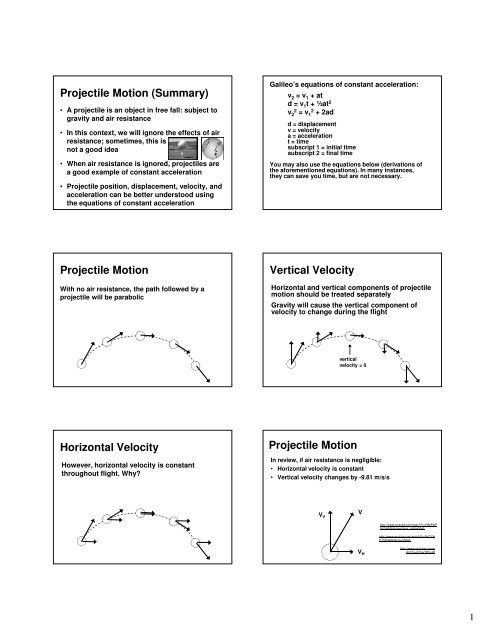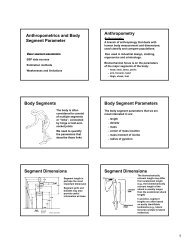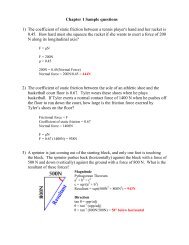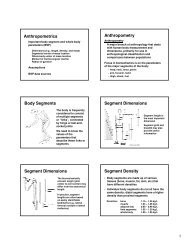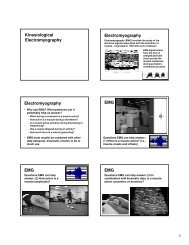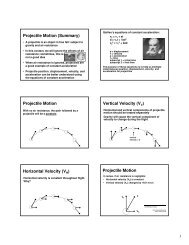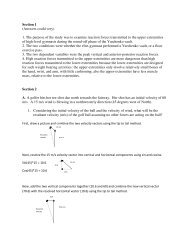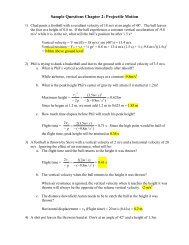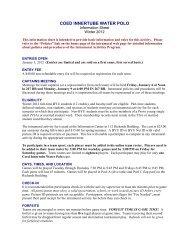Projectile Motion (Summary) Projectile Motion Vertical Velocity ...
Projectile Motion (Summary) Projectile Motion Vertical Velocity ...
Projectile Motion (Summary) Projectile Motion Vertical Velocity ...
- No tags were found...
Create successful ePaper yourself
Turn your PDF publications into a flip-book with our unique Google optimized e-Paper software.
<strong>Projectile</strong> <strong>Motion</strong> (<strong>Summary</strong>)• A projectile is an object in free fall: subject togravity and air resistance• In this context, we will ignore the effects of airresistance; sometimes, this isnot a good idea• When air resistance is ignored, projectiles area good example of constant acceleration• <strong>Projectile</strong> position, displacement, velocity, andacceleration can be better understood usingthe equations of constant accelerationGalileo’s equations of constant acceleration:v 2 = v 1 + atd = v 1 t + ½at 2v 22 = v 12 + 2add = displacementv = velocitya = accelerationt = timesubscript 1 = initial timesubscript 2 = final timeYou may also use the equations below (derivations ofthe aforementioned equations). In many instances,they can save you time, but are not necessary.2(V1)Maximal Height =− 2g(2V1)Time of Flight =- g2- V1- V1- 2ghTime of Flight =g<strong>Projectile</strong> <strong>Motion</strong>With no air resistance, the path followed by aprojectile will be parabolic<strong>Vertical</strong> <strong>Velocity</strong>Horizontal and vertical components of projectilemotion should be treated separatelyGravity will cause the vertical component ofvelocity to change during the flightverticalvelocity = 0Horizontal <strong>Velocity</strong>However, horizontal velocity is constantthroughout flight. Why?<strong>Projectile</strong> <strong>Motion</strong>In review, if air resistance is negligible:• Horizontal velocity is constant• <strong>Vertical</strong> velocity changes by -9.81 m/s/sV VVhttp://www.youtube.com/watch?v=R6pPwP3s7s4&feature=player_embeddedhttp://www.youtube.com/watch?v=PvC33gSTSR4&feature=relatedV Hhttp://www.youtube.com/watch?v=37qyvTRVus81
<strong>Vertical</strong> <strong>Projectile</strong> <strong>Motion</strong><strong>Vertical</strong> motion of a projectile (e.g., a water balloonthat is dropped from the edge of a building) is verypredictabled = v 1 t + ½at 2v 2 = v 1 + at0 m-10 m-20 m<strong>Vertical</strong> <strong>Projectile</strong> <strong>Motion</strong>d = v 1 t + ½at 2and v 2 = v 1 + at0 m-10 m-20 mtime position velocity acceleration0 s-30 m-40 mtime position velocity acceleration0 s 0 m 0 m/s −9.8 m/s 2-30 m-40 m1 s-50 m1 s-50 m2 s-60 m2 s-60 m3 s3 s<strong>Vertical</strong> <strong>Projectile</strong> <strong>Motion</strong><strong>Vertical</strong> <strong>Projectile</strong> <strong>Motion</strong>d = v 1 t + ½at 2and v 2 = v 1 + at0 md = v 1 t + ½at 2and v 2 = v 1 + at0 m-10 m-10 m-20 m-20 mtime position velocity acceleration0 s 0 m 0 m/s −9.8 m/s 2-30 m-40 mtime position velocity acceleration0 s 0 m 0 m/s −9.8 m/s 2-30 m-40 m1 s −4.9 m −9.8 m/s −9.8 m/s 2-50 m1 s −4.9 m −9.8 m/s −9.8 m/s 2-50 m2 s-60 m2 s −19.6 m −19.6 m/s −9.8 m/s 2-60 m3 s3 s<strong>Vertical</strong> <strong>Projectile</strong> <strong>Motion</strong>d = v 1 t + ½at 2and v 2 = v 1 + at0 mAnother exampleHow high was the cliff (what is d V )?-10 m-20 mtime position velocity acceleration0 s 0 m 0 m/s −9.8 m/s 21 s −4.9 m −9.8 m/s −9.8 m/s 22 s −19.6 m −19.6 m/s −9.8 m/s 23 s −44.1 m −29.4 m/s −9.8 m/s 2-30 m-40 m-50 m-60 m2
Another exampleHow high was the cliff (what was d V )?t DOWN = ~ 2 s, and usingd V = V 1 t + ½at 2 , we learnedthat:d V = 0 + ½ · -9.81m/s 2 · 2s 2 ,-19.6 mPerhaps, more importantly, what was V F ?V F = 0 + -9.81m/s 2 · 2s = 19.62 m/s, or ~44 mphHorizontal <strong>Projectile</strong> <strong>Motion</strong>The horizontal displacement, or range of aprojectile, is the main performance index inmany cases.If air resistance is considered to be negligible,there is no net force in the horizontal direction(ΣF x = 0; a x = 0)Given the equation: d = v 1 t + ½at 2 ,we can assume that: d X = V X × tHorizontal <strong>Velocity</strong>So, d X = V X × t, allows us to calculate horizontalrange for a projectile, if we know the horizontalvelocity and air time. First, what affectshorizontal velocity?Flight TimeNext, what affects flight time? (two primary factors)1. <strong>Vertical</strong> speed at release: affected byangle of release and applied force2. Height of release(if takeoff height = landing height, then t UP = t DOWN )t UPt DOWNSome ApplicationBased upon what we havelearned, what factors can onemanipulate to influence thehorizontal displacement, orrange, of a projectile? What ismost important?Relative Height of ReleaseSpeed of ReleaseAngle of ReleaseWhat is most important?Does increasing the height of release alwayslead to greater d x ?Yes, why?d x = v x × tDoes increasing speed of release always leadto greater d x ?Yes, but again, why?d x = v x × t3
What is most important?What about angle of release?When height of release is 0 m, optimal anglefor maximum d x is 45°As height of release ↑, optimal angle ↓d x = v x × tWhat is most important?d H is most sensitive to speed of release…d x = v x × tSpeed of release can positively affect v H and t TOTWhat are the performance-relatedimplications of this information?More Application…How do actual release angles compare totheoretical optima?Shot Put:• Positive height of release, so optimal angleshould be slightly lower than 45°• Theoretically optimal angle is about 40-41°More Application…Long Jump:Positive height of release, so optimal angleshould be slightly lower than 45°• Skilled shot-putters use angles of 31-36°• Close, but why the discrepancy?<strong>Projectile</strong> <strong>Motion</strong>:Theory vs RealityLong Jump:• Theoretically optimal angle is about 42°• Top long jumpers use angles of 17-23°• Very different. Why the major discrepancy?When traveling at ~10 m/s, there is not enoughtime to generate a large takeoff angleLong jumpers sacrifice optimal angle to getmaximum speed.<strong>Projectile</strong> <strong>Motion</strong> (<strong>Summary</strong>)• A projectile is an object in free fall: subject togravity and air resistance• In this context, we will ignore the effects of airresistance; sometimes, this isnot a good idea• When air resistance is ignored, projectiles area good example of constant acceleration• <strong>Projectile</strong> position, displacement, velocity, andacceleration can be better understood usingthe equations of constant acceleration4
Some Practice: The Shot PutHow far will the shot travel?Remember: d H = v H × tCase Ispeed of release = 12 m/sheight of release = 0 mangle of release = 30°0 m30°12 m/sSome Practice: The Shot PutUse d H = v H tneed to know v H and tv H = v cos θ = 12 m/s ⋅ cos 30° = 10.4 m/sWhat is total time in the air (t TOT )?If height of release = 0, then t UP = t DOWNand t TOT = t UP + t DOWNWhat else do we know?For upward part of flight:v 1 = v V = v · sin θ = 12 m/s ⋅ sin 30° = 6 m/sv 2 = 0 m/s a = −9.81 m/s 2Some Practice: The Shot PutFind appropriate equation for constant accelerationv 2 = v 1 + atPlug in v 1 , v 2 , and a, then solve for t:0 m/s = 6 m/s + (−9.81m/s 2 )(t UP )t UP = 0.61 sSome Practice: The Shot PutLets use a more realistic height of releaseCase IIspeed of release = 12 m/sheight of release = 2.1 mangle of release = 30°t TOT will be 2 × t UP : t TOT = 2 × 0.61 s = 1.22 s (Why ?)d H = v H t TOT = 10.4 m/s × 1.22 s = 12.7 mSo, the shot traveled 12.7 m horizontally2.1 m30°12 m/sSome Practice: The Shot PutWe still use d H = v H t , but now t UP ≠ t DOWNv H is found the same way as before:v H = v cos θ = 12 m/s ⋅ cos 30° = 10.4 m/sand t UP is also the same (using v 2 = v 1 + at):0 m/s = 6 m/s + (−9.81m/s 2 )(t UP )t UP = 0.61 sSo how do we calculate t DOWN ?We need to find the upward (d UP ) anddownward (d DOWN ) displacementsSome Practice: The Shot PutFind another appropriate equationd = v 1 t + ½at 2Calculate the upwards displacement:d UP = (6 m/s)(0.61 s) + ½ (−9.81 m/s 2 )(0.61 s) 2 = 1.83 md DOWN = d UP + ht of release = 1.83 m + 2.1 m = 3.93 mbut this is in the negative direction, so it is −3.93 mNow find t DOWN :−3.93 m = (0 m/s) t DOWN + ½ (−9.81 m/s 2 )(t DOWN ) 20.8012 s 2 = (t DOWN ) 2 , so t DOWN = 0.90 s5
Some Practice: The Shot PutNow calcuate t TOTt TOT = t UP + t DOWN = 0.61 s + 0.90 s = 1.51 sand finally, calculate the horizontal displacement:d H = v H t TOT = 10.4 m/s × 1.51 s = 15.7 mSo, now the shot travels 15.7 m horizontallyThe increased height of release resulted in a3.0 m (~20%) improvement in performance!6


